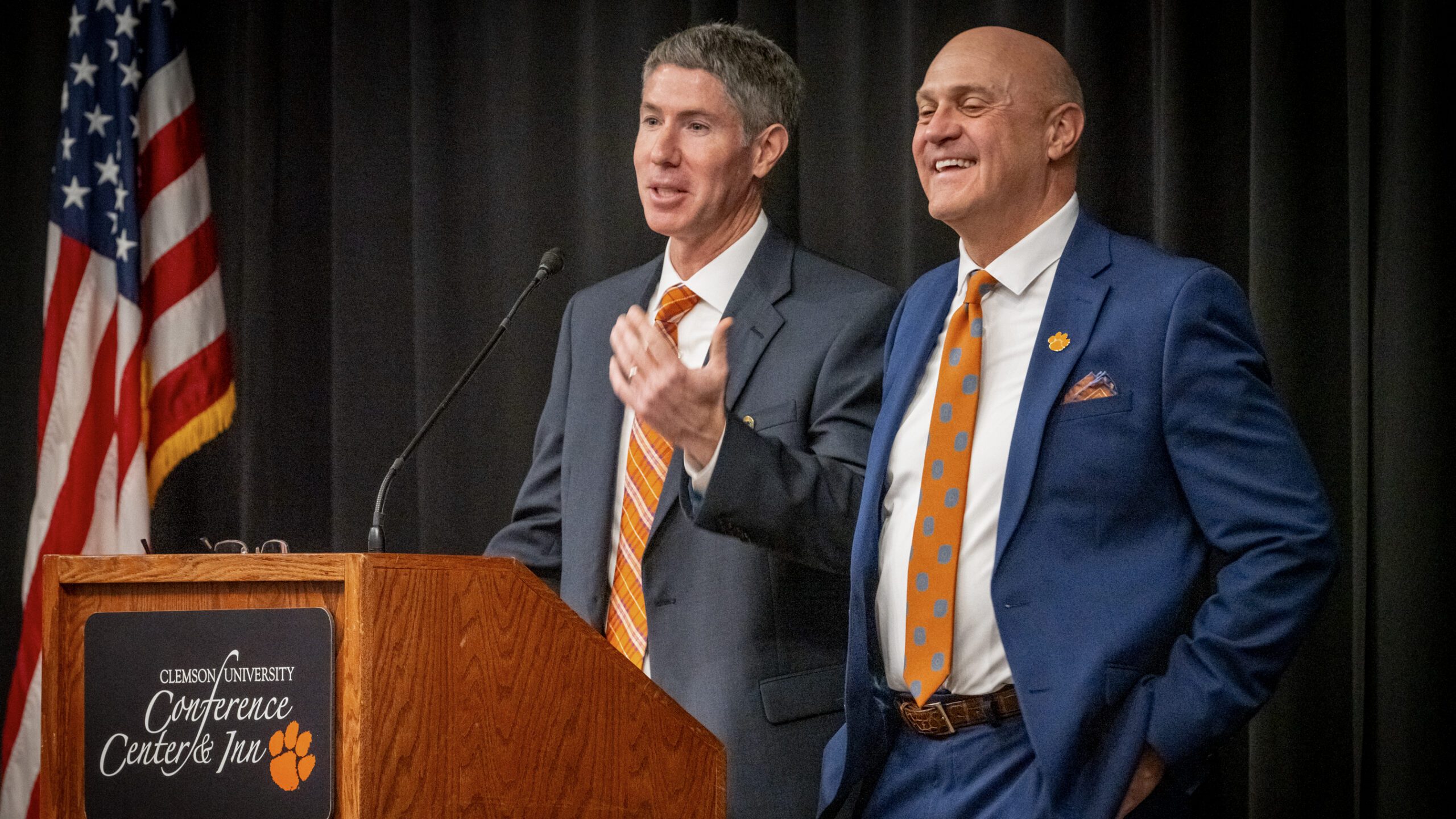City of Clemson, University leaders celebrate partnership, success at annual State of Clemson event
February 28, 2024Mayor Robert Halfacre and President Jim Clements take questions during the State of Clemson event
Clemson University and the City of Clemson Chamber of Commerce hosted the annual “State of the University/State of the City” event Monday afternoon to celebrate the past year’s accomplishments alongside the enduring partnership between the University and the city. University president Jim Clements and Clemson Mayor Robert Halfacre shared the stage to deliver addresses to an enthusiastic crowd in the Madren Center made up of members of the Clemson Chamber of Commerce, the Joint City-University Advisory Board, elected officials, University officials, students and community members.
Clements, now in his 11th year as University president, used his remarks to highlight the collaboration and teamwork between the city and University.
“The continued success of the Welcome Back Festival is a testament to the collaboration and teamwork of the city and University,” said Clements. “And that is just one example of how the University and the city partner together.”
Clements shared three things he finds very special at Clemson: the culture, the people, and the 12-year Clemson Elevate plan to propel the University’s success and build on its strong reputation.
“Across the University, we have built a national championship culture, not just in athletics but also in academics, research, student life, facilities and so much more,” said Clements. “Recently, we were ranked the third most trusted public university in the country. Trust is a very important thing. Sometimes, it is hard to earn, but it can be easily broken. Trust is earned by doing the right thing all the time.”
Safety first
Clements noted that Clemson was recently listed as the second safest college campus in the country, and the City of Clemson was named one of the top ten safest cities in South Carolina. He said that is thanks to the Clemson University Police Department, the Clemson City Police Department and the Clemson University Fire Department, which serves both the University and the City in partnership with Pickens County EMS.
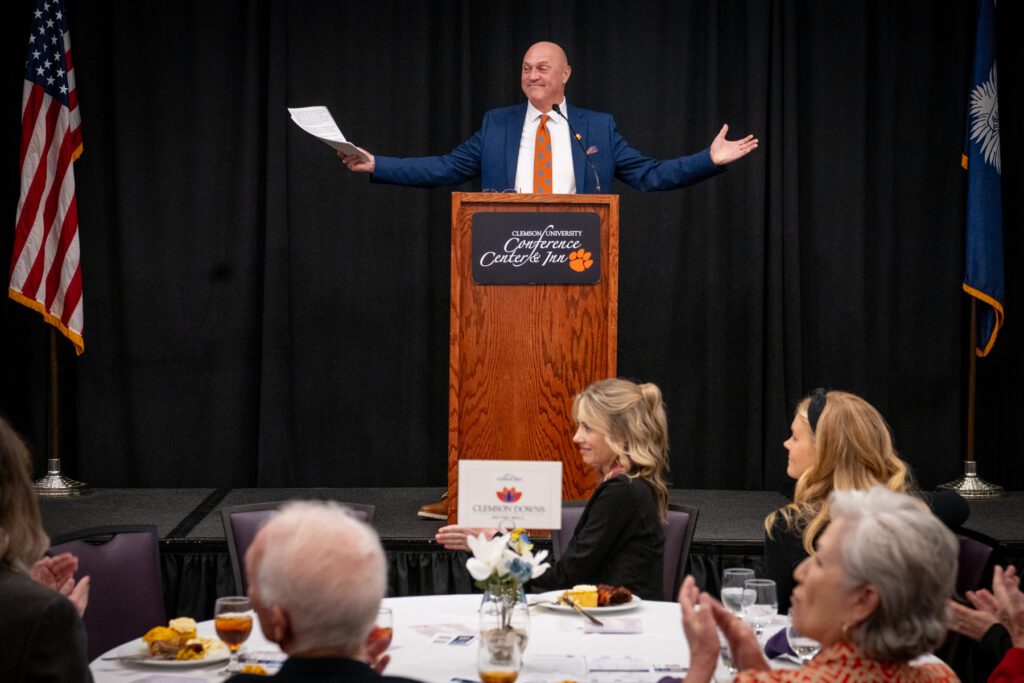
President Jim Clements speaks at the State of Clemson event in the Madren Center.
“But . . . it’s not [just] the police force, the fire department or EMS that makes us one of the safest universities and communities in the country,” said Clements. “It’s our culture. It’s our people, our community, our faculty, our staff and our students.”
After lauding several of the University’s growth percentages and national rankings, including being named the No. 1 university in South Carolina by the Wall Street Journal, Clements focused on the relationship between Clemson’s 28,747 students and the community.
“Our students are amazing. They are excelling in the classroom and engaging with the community,” said Clements, using robust student participation in January’s Martin Luther King Jr. Day of Service as one example.
Clements then highlighted an area particularly dear to his heart: the partnerships between the community and the University’s Clemson LIFE program.
“Many of you know my daughter, Amazing Grace, is in her third year of Clemson LIFE,” said Clements. “She has also been working at Your Pie and TD’s this year. She’s loving it and learning a lot, and it wouldn’t be possible without the community and the University working together.”
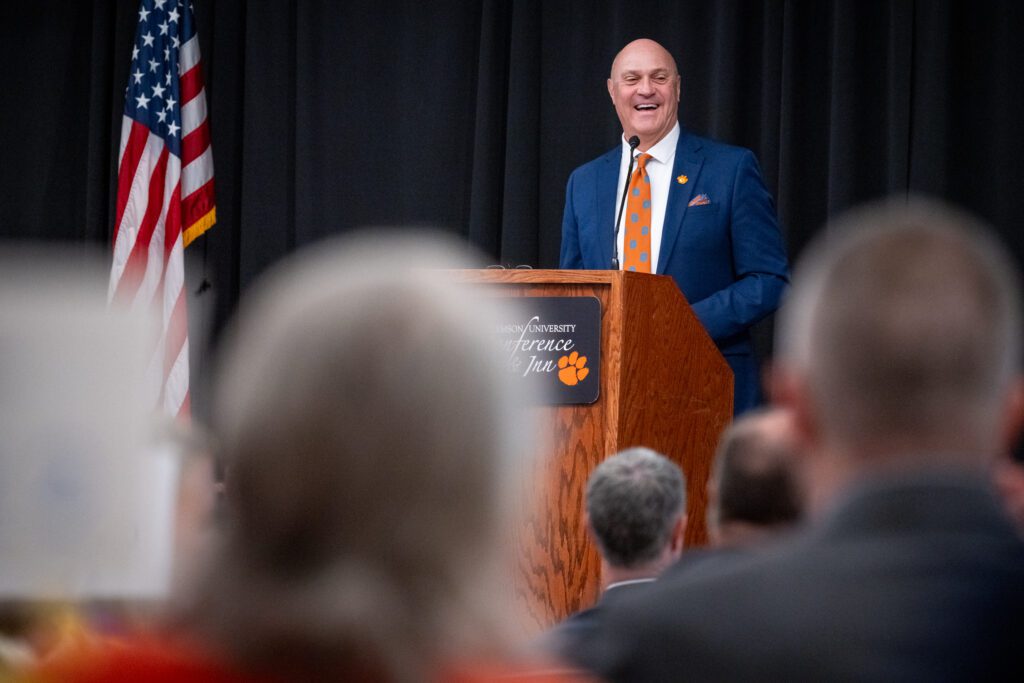
Clemson University and the City of Clemson Chamber of Commerce hosted the annual “State of the University/State of the City” event Monday afternoon to celebrate the past year’s accomplishments alongside the enduring partnership between the University and the city. University president Jim Clements and Clemson Mayor Robert Halfacre shared the stage to deliver addresses to an enthusiastic crowd in the Madren Center made up of members of the Clemson Chamber of Commerce, the Joint City-University Advisory Board, elected officials, University officials, students and community members. (Photo by Ken Scar)
Clements noted that he has signed the diplomas of almost 64,000 out of Clemson’s 182,133 living alumni.
“That means more than one-third of our alumni are really young – 32 and under – and they are looking for ways to engage with us and stay connected,” he said. “They come back to Clemson for events like Homecoming, Alumni Spring Break and the Clemson Music Festival, which we are putting on together for the first time in April.”
Clements said another excellent example of the City and University working together is the Green Crescent Trail system, a network of multiple pedestrian and biking paths linking the Clemson-Central-Pendleton community, which started as a class project in a Clemson architecture class. He pointed out that Halfacre was a champion of the project along with Clemson Provost and Executive Vice President Bob Jones.
Mayor Halfacre also touched on the City’s efforts for environmental sustainability, echoing Clements’ celebration of the completion of the first phase of the Green Crescent Trail and expressing gratitude for the University’s Kite Hill Recycling station, which provides city residents an additional drop-off location for recyclables.
Pickleball courts expansion
Clements announced the University and City are partnering to build eight new pickleball courts in Nettles Park, which should be completed this September. He also lauded the completion of several new facilities on campus, including new lacrosse, rowing and gymnastics complexes.
“How many of you have been to one of our gymnastics meets in Littlejohn Coliseum?” Clements asked the crowd. “That’s 9,000 people coming to Clemson, staying at our hotels, eating at our restaurants, and supporting local businesses.”
When Clements finished his remarks he introduced Halfacre, who presented Clements with a gift from the city commemorating his ten years at Clemson: A custom Clemson-branded pickleball paddle.
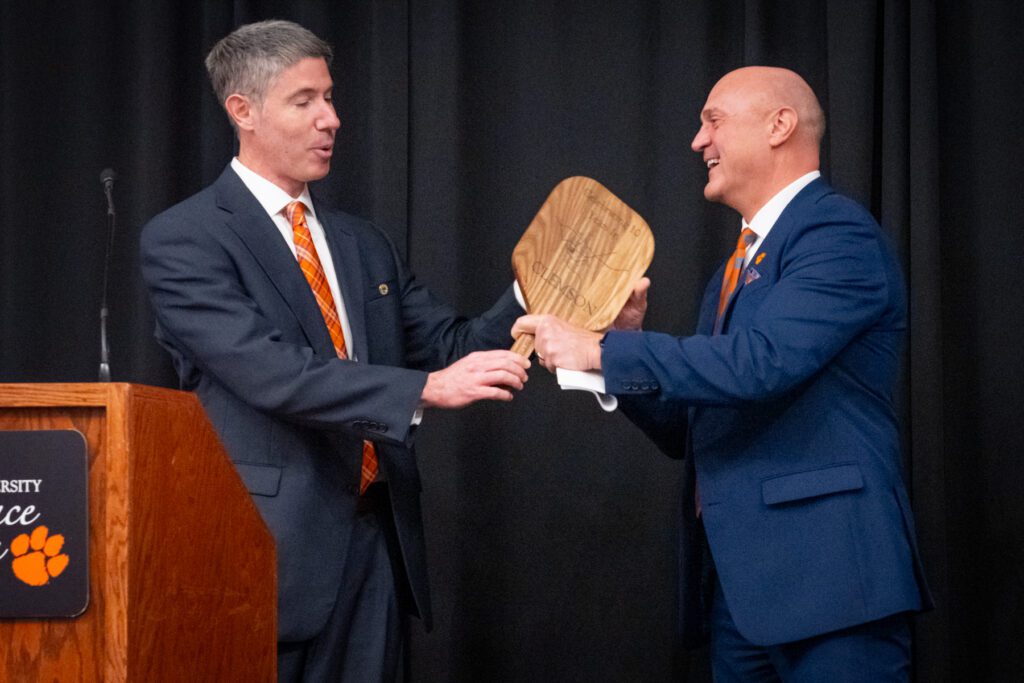
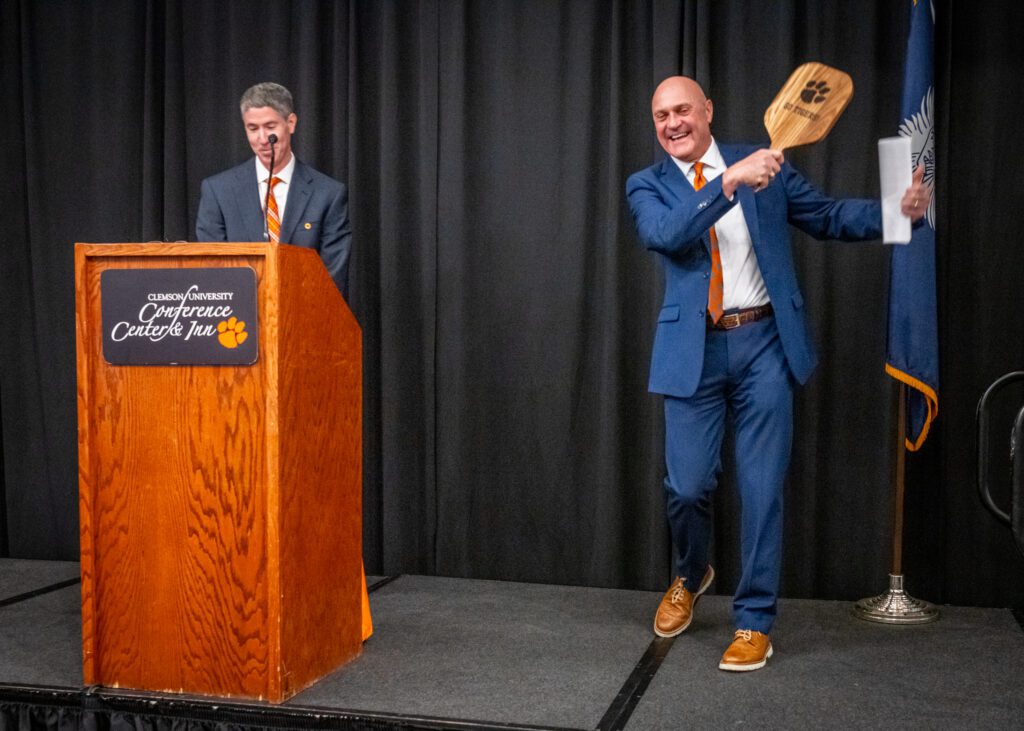
Mayor Robert Halfacre presents President Jim Clements with a special pickleball paddle as a gift from the city of Clemson.
Halfacre started his speech by noting how difficult it is to condense a year of accomplishments into one easily digestible speech.
“Each year, when I reflect on our community’s activities and accomplishments, I am faced with one problem: how do I summarize all of the hard work put forth by our community, city team, and council in a way that does justice to those efforts but also doesn’t occupy everyone’s entire afternoon,” he joked before highlighting an impressive list of efforts made by the City in the last year, beginning with a “conscious progressing towards equity for all.”
Growing healthy communities on and off campus
Halfacre went on to underscore the City’s focus on offering healthy living opportunities to residents across all life spans, including an adaptive yoga class each Friday, free senior fitness classes, senior bingo sessions and an annual senior trip and holiday luncheon, and the City’s offerings in art and culture in the Arts Center and the Clemson-Area African American Museum.
Halfacre used a few minutes to brag about a few of the City’s athletic accomplishments, starting with the City’s 8U boys’ soccer team winning the state championship this year.
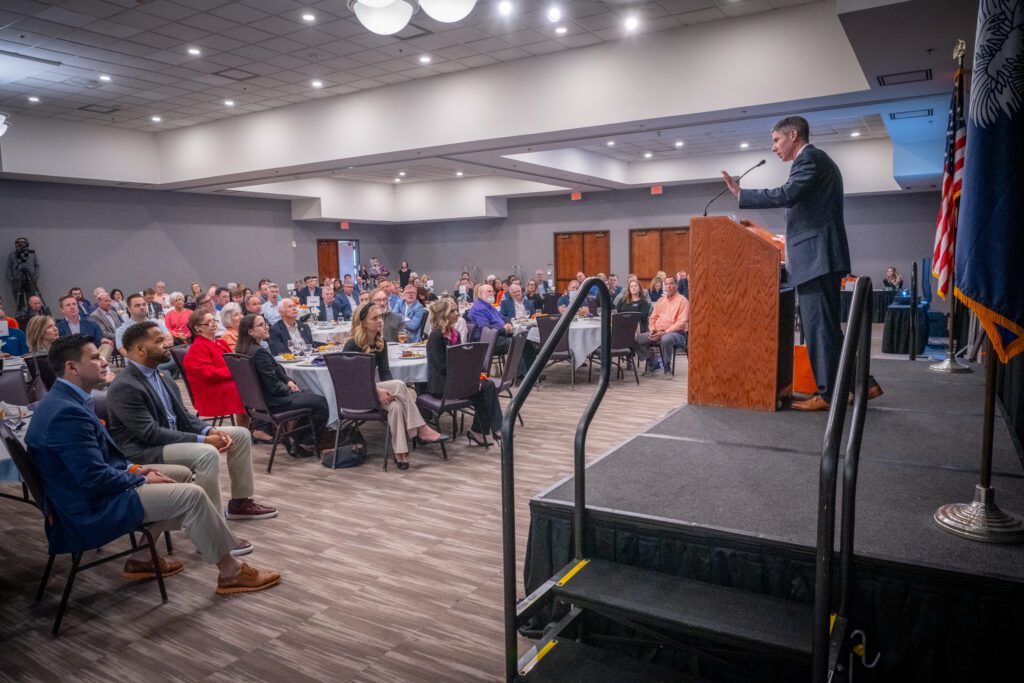
Mayor Robert Halfacre addresses the crowd.
“And speaking of championships, Daniel High School won state in soccer, band, and football,” said Halfacre. “Many of these students got their start in our recreational sports. They’re also fortunate to be so close to Clemson University and their distinguished athletic programs, including several national championships, the most recent of which was the 2023 soccer team.”
Halfacre touched on the City’s efforts for environmental sustainability, echoing Clements’ celebration of the completion of the first phase of the Green Crescent Trail and expressing gratitude for the University’s Kite Hill Recycling station, which provides city residents an additional drop-off location for recyclables.
The mayor highlighted the city’s growth plan, which he said is based on healthy, transit-oriented design principles, and the city’s efforts to create a resilient economic environment for residents, businesses and nonprofits. He used the On the Ave and Rock the Block events as examples, as both successful programs brought business to downtown and Patrick Square on typically slower nights.
Echoing Clements’ pride at the city and University’s high rankings for safety, Halfacre said three additional sworn officers were added to the city’s police force this year, and five new police cruisers are being fitted for service. He also announced the city and University’s joint Fire/EMS are in the process of purchasing a new fire truck.
“We, of course, share a Fire/EMS department and work together frequently on ensuring public safety, especially on those seven weekends out of the year that our population increases by 100,000,” Halfacre said. “But in truth, all of our programs are inextricably tied. Our recreational programs rely on volunteers and interns to run smoothly, and our transit systems transport students, faculty, and staff to and from campus. Our programs are made better when we work together and utilize our strengths.
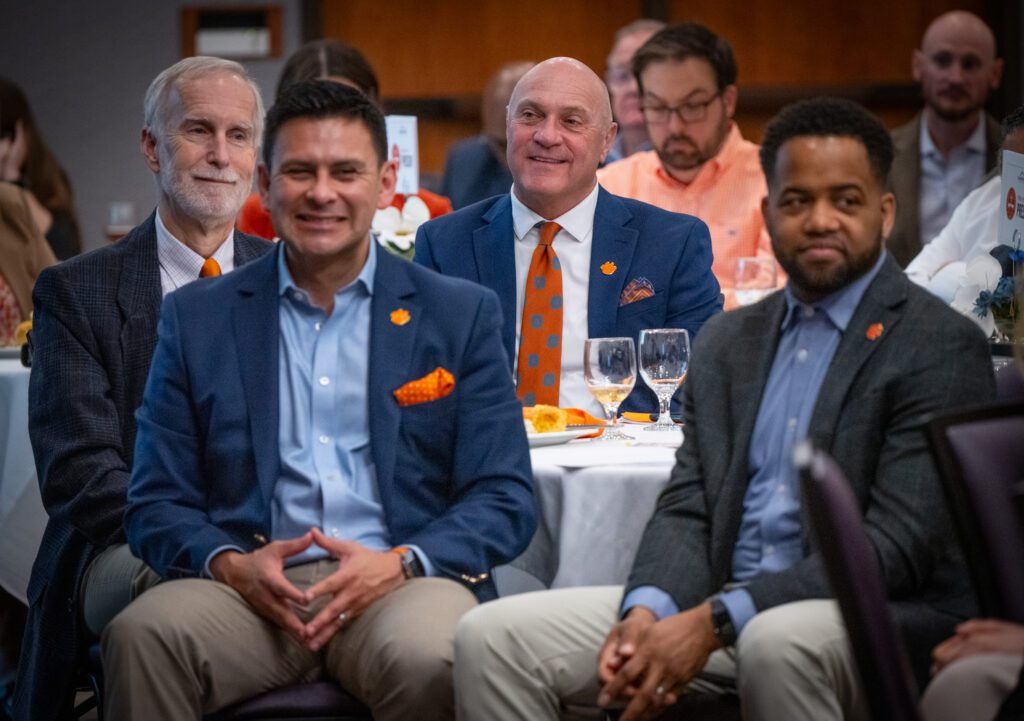
“I truly feel that Clemson is a special place, and these moments where I can reflect on where we’ve been and where we’re going only reinforce that feeling,” he said. I’m proud to be a part of this outstanding community of people.”
Clements closed by quoting Felicia Benton-Johnson, the University’s vice president for diversity and inclusive excellence.
“She likes to say, ‘One band, one sound,’” said Clements. “That is how I think about the University and the city. I am proud of what I see when I look at Clemson. We will always be working to move from point A to an even better point B, and, most importantly, we will be elevating Clemson together.”






